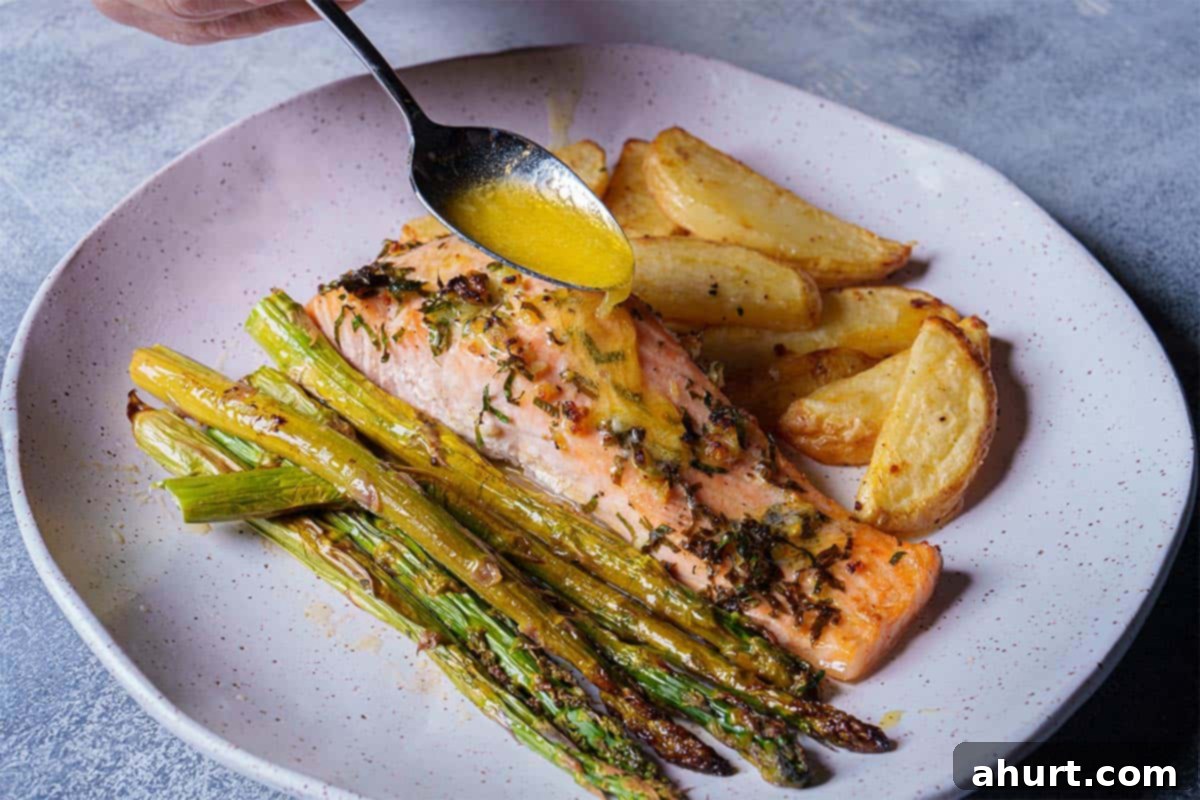Ultimate Sheet Pan Garlic Butter Baked Salmon: An Effortless & Flavorful Weeknight Meal
Discover the ultimate recipe for a truly unforgettable meal: our **Garlic Butter Baked Salmon**! This dish effortlessly combines gourmet flavor with remarkable simplicity, making it your ideal choice for everything from a quick weeknight dinner to an elegant feast. Imagine tender, flaky salmon fillets infused with rich, aromatic garlic butter, perfectly baked alongside crisp-tender asparagus and golden potatoes. This isn’t just a meal; it’s a culinary experience that proves simple ingredients can deliver extraordinary results every single time.
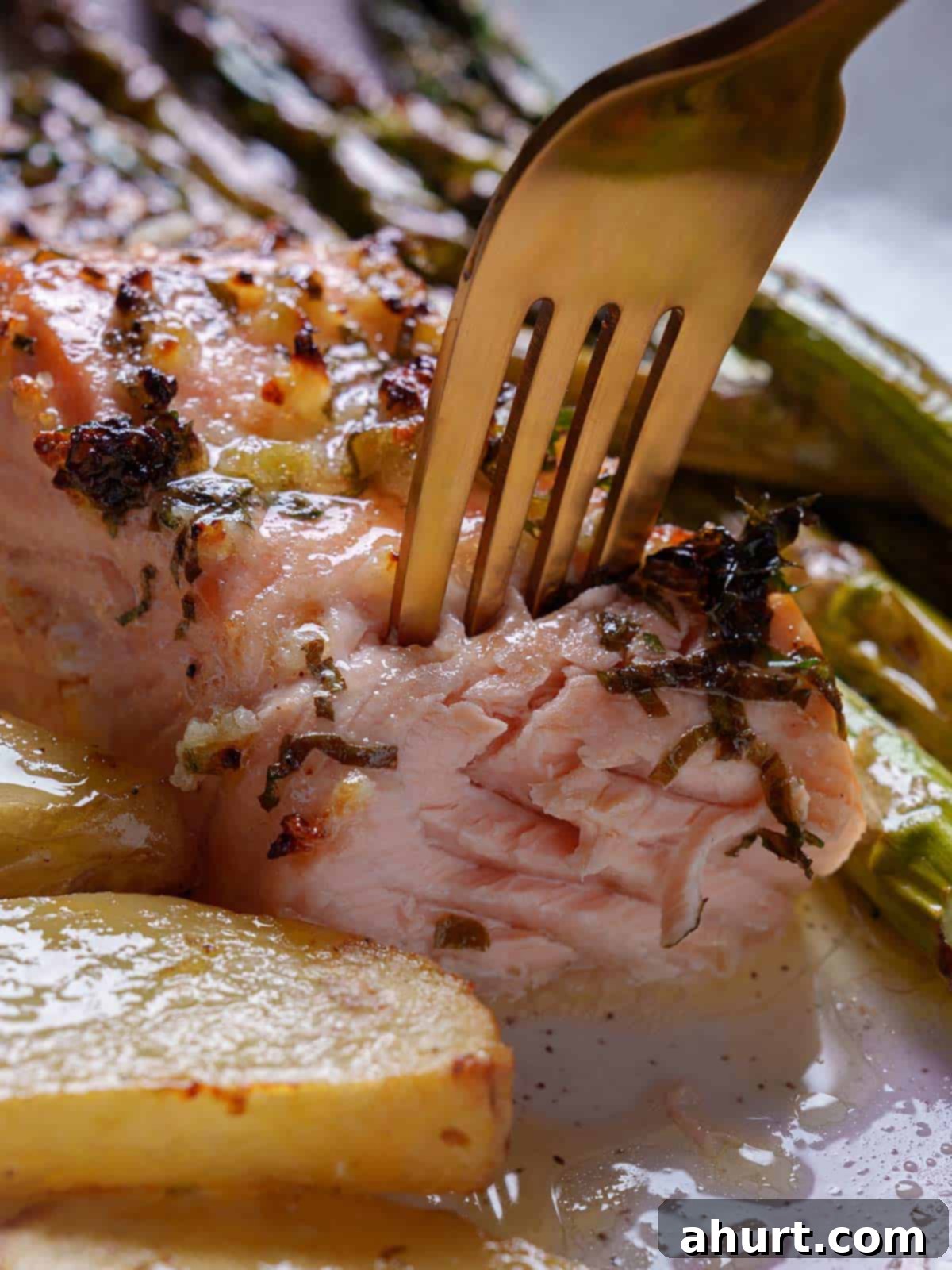
Why This Garlic Butter Baked Salmon Recipe Will Become Your New Favorite
Our **Garlic Butter Baked Salmon** isn’t just another fish recipe; it’s a testament to the power of simple ingredients creating a profound flavor. This method offers the perfect blend of easy preparation and impressive taste, ensuring you can enjoy a restaurant-quality meal without the fuss. Here’s why this particular salmon dish stands out:
- Effortless Elegance: With just a few staple ingredients like fresh **garlic, rich butter, bright lemon, and vibrant herbs**, you’ll create a dish bursting with flavor that feels both indulgent and wonderfully easy. It’s perfect for impressing guests or simply treating yourself to a gourmet experience at home.
- One-Pan Perfection: This **sheet pan salmon recipe** is designed for maximum flavor and minimal cleanup. Roasting everything on a single pan allows the flavors to meld beautifully while significantly cutting down on washing up – a true win for busy weeknights!
- Healthy & Wholesome: Salmon is a powerhouse of nutrition, rich in Omega-3 fatty acids, protein, and essential vitamins. Paired with fresh vegetables, this dish offers a complete, balanced, and incredibly satisfying meal that supports a healthy lifestyle.
- Melt-in-Your-Mouth Texture: While pan-seared salmon offers a crispy skin, this baked version excels in delivering an unbelievably **tender and flaky salmon** fillet. The baking process gently cooks the salmon, allowing it to soak up all the garlicky, buttery goodness, creating a succulent texture that practically melts in your mouth. The edges get a delightful buttery kiss, adding another layer of texture.
- Pantry-Friendly Ingredients: You won’t need any exotic items for this recipe. Most of the ingredients are likely already in your kitchen, making it incredibly accessible. These versatile staples aren’t just for salmon; they are the foundation for many delicious dishes, like Garlic Butter Shrimp, showcasing their adaptability.
Forget complicated cooking techniques. This **easy baked salmon** is about enjoying incredible food with minimal stress. It’s the kind of simple, yet sophisticated meal you’ll want to master and make again and again!
Garlic Butter Baked Salmon: Essential Ingredients for Flavor
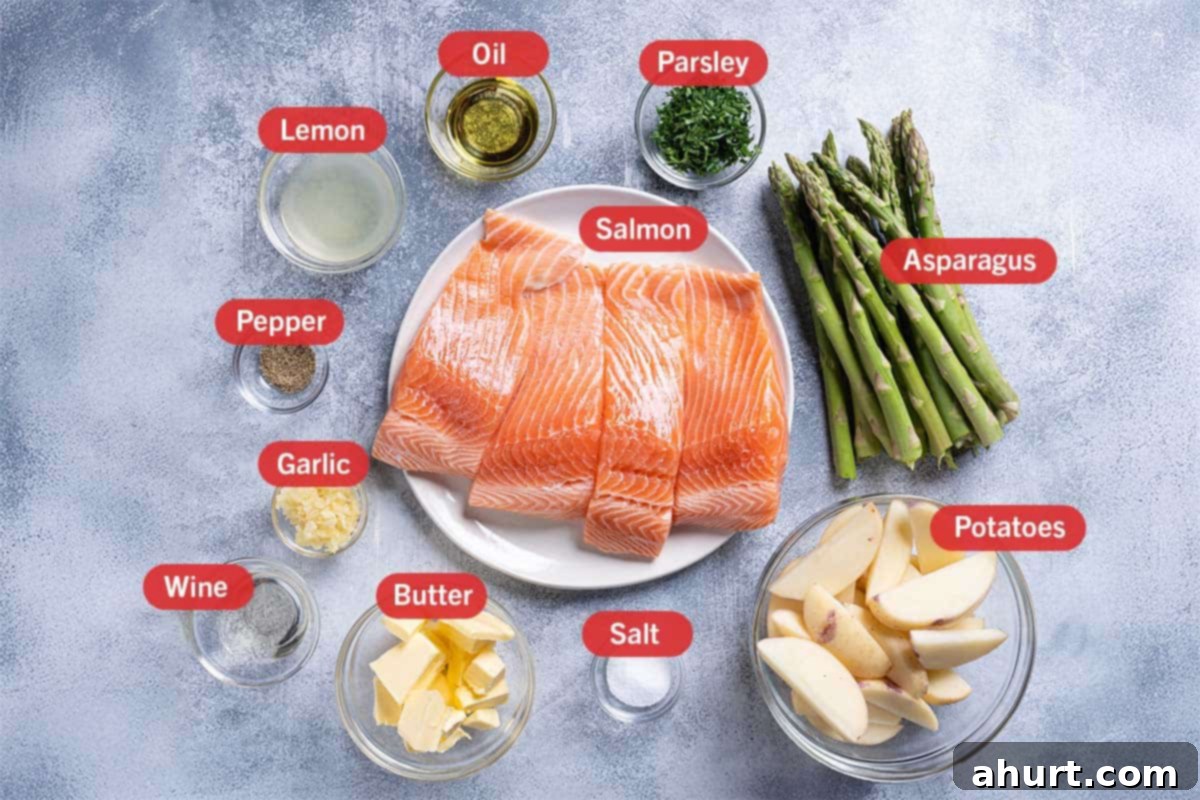
The secret to creating truly exceptional **Garlic Butter Baked Salmon** lies in selecting high-quality, fresh ingredients. Each component plays a crucial role in building the dish’s vibrant and unforgettable flavor profile. Here’s a closer look at the stars of this recipe:
- Salmon Fillets: The heart of this dish! Opt for fresh, high-quality salmon fillets, about 1-inch thick, to ensure even cooking and a wonderfully tender texture. While any salmon will do, choosing **wild-caught salmon** can elevate the flavor significantly and offers a denser nutritional profile, making it a key ingredient in creating that rich taste reminiscent of a premium Lemon Butter Garlic Salmon. Ensure the skin is removed unless you prefer it crispy (though for this baked method, skinless is often preferred for a consistent texture).
- Fresh Garlic: This is non-negotiable for a genuine **garlic butter salmon** experience. Fresh garlic cloves bring a bold, pungent, and aromatic flavor that pre-minced options simply cannot replicate. Take the time to finely mince the cloves yourself; this ensures an even distribution of flavor and an irresistible aroma throughout the dish.
- Unsalted Butter: High-quality unsalted butter is paramount for full control over the seasoning. Its velvety richness forms the base of the luscious garlic butter sauce. Beyond flavor, butter contributes to the beautiful browning and crisping of the edges of both the salmon and the accompanying vegetables as they bake. If using salted butter, simply adjust the added salt in the recipe.
- Lemon Juice: Freshly squeezed lemon juice brightens the entire dish, cutting through the richness of the butter and complementing the salmon’s natural flavor. It adds a crucial zest and acidity that elevates the garlic butter sauce. Always use fresh lemons for the best taste.
- Fresh Parsley: Chopped fresh parsley adds a burst of herbaceous freshness and a lovely pop of color. It’s not just a garnish; its subtle peppery notes enhance the overall flavor. Other fresh herbs like dill or chives also work wonderfully.
- Potatoes: Fingerling, Yukon Gold, or small red/white baby potatoes, halved, are perfect for roasting alongside the salmon. They get delightfully tender on the inside and crispy on the outside, absorbing the wonderful flavors from the pan.
- Asparagus: These vibrant green spears add a fresh, slightly earthy flavor and a satisfying snap when roasted. Ensure you snap off the woody ends for the best texture.
- Olive Oil: Used primarily for tossing the potatoes, olive oil helps them crisp up beautifully and adds a subtle fruity note.
- Dry White Wine (Optional): A splash of dry white wine in the finishing sauce adds depth and complexity. If you prefer to skip alcohol, low-sodium chicken broth is an excellent substitute.
*Note: For a comprehensive list of all ingredients and precise measurements, please refer to the detailed Recipe Card located at the bottom of this page.
Creative Additions And Smart Substitutions for Your Baked Salmon
One of the many joys of cooking **Garlic Butter Baked Salmon** is its incredible versatility. Don’t have an ingredient on hand, or simply want to try something new? No problem! These smart substitutions and additions will ensure your buttery, garlicky flavor shines through every time, allowing you to tailor this **easy salmon recipe** to your taste or what’s available in your pantry.
- Vegetable Variations: While asparagus and potatoes are classics, feel free to get creative with your produce.
- Green Beans: Toss them with olive oil, salt, and pepper, and roast alongside the salmon for a similar crisp-tender texture.
- Broccoli or Broccolini: These florets roast beautifully and add a delightful earthy flavor.
- Zucchini or Bell Peppers: Sliced zucchini or colorful bell peppers can add a different texture and a hint of sweetness. Ensure they are cut into similar-sized pieces for even cooking.
- Cherry Tomatoes: Add them during the last 10 minutes of baking; they’ll burst and create a lovely sweet and acidic counterpoint to the dish.
- Citrus Twist: Lemon is classic, but other citrus fruits can introduce exciting new flavor dimensions.
- Lime: Offers a brighter, more pungent zest that pairs wonderfully with garlic and butter.
- Blood Orange: For a subtly sweeter and more visually stunning twist, blood orange slices or juice can elevate the buttery sauce beautifully.
- Orange: A common navel orange provides a sweeter, milder citrus note.
- Potato Options: Beyond fingerlings, many potatoes work well for roasting.
- Sweet Potatoes: Cubed sweet potatoes bring a different texture and a lovely hint of sweetness that caramelizes beautifully.
- Red or Yellow Baby Potatoes: Halved or quartered, these are perfect for roasting, offering a creamy interior and crisp exterior.
- Small Yukon Golds: Known for their buttery flavor and smooth texture, they are an excellent choice.
If you’re particularly keen on crispy potatoes, you might enjoy trying these Crispy Garlic Roasted Potatoes as a separate side!
- Herb Enhancements: Don’t limit yourself to parsley.
- Dill: A natural pairing for salmon, dill adds a fresh, slightly anise-like flavor.
- Thyme or Rosemary: A sprig or two added to the pan can infuse the entire dish with a wonderful woody aroma.
- Chives: For a milder oniony flavor, sprinkle fresh chives over the finished dish.
- Spicy Kick: For those who love a bit of heat, consider adding a pinch of red pepper flakes to the garlic butter sauce or a dash of hot sauce before serving.
Experimentation is key! These variations allow you to customize your **sheet pan salmon** to suit any preference or occasion, making this recipe truly your own.
Crafting Perfect Garlic Butter Baked Salmon: Your Easy Step-By-Step Guide
Ready to cook? This **Garlic Butter Baked Salmon** recipe is designed for ease and maximum flavor. With just a handful of straightforward steps, you’ll have a mouth-watering, healthy dinner ready to impress. Follow along, and let’s create culinary magic in your kitchen!
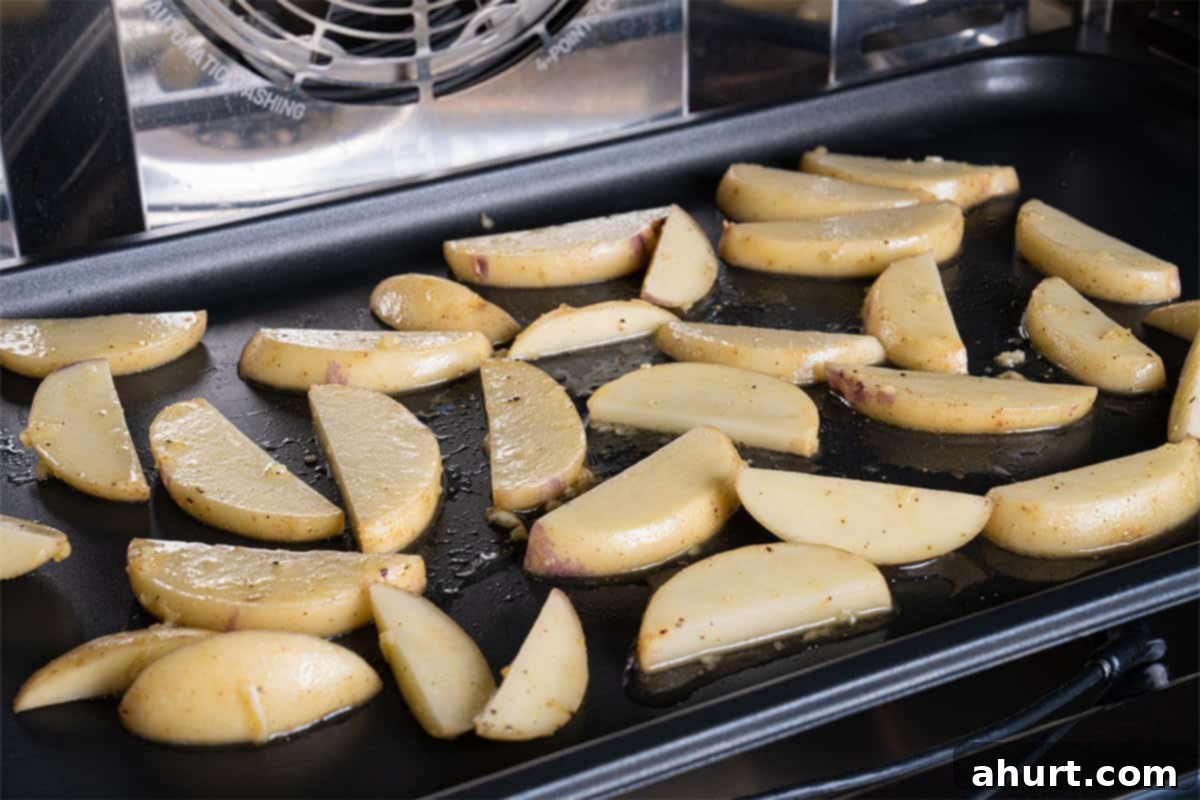
- Preheat Oven and Roast Potatoes: Begin by preheating your oven to a robust 400°F (200°C). This ensures your potatoes will start crisping immediately. On a large, rimmed baking sheet (essential for containing all the delicious juices!), toss your prepared potatoes with olive oil, a portion of the minced garlic, salt, and pepper. Spread them out in a single, even layer – this is crucial for achieving that desirable crispiness. Roast them for an initial 15 minutes, until they just start to soften and develop a lovely golden-brown crust.
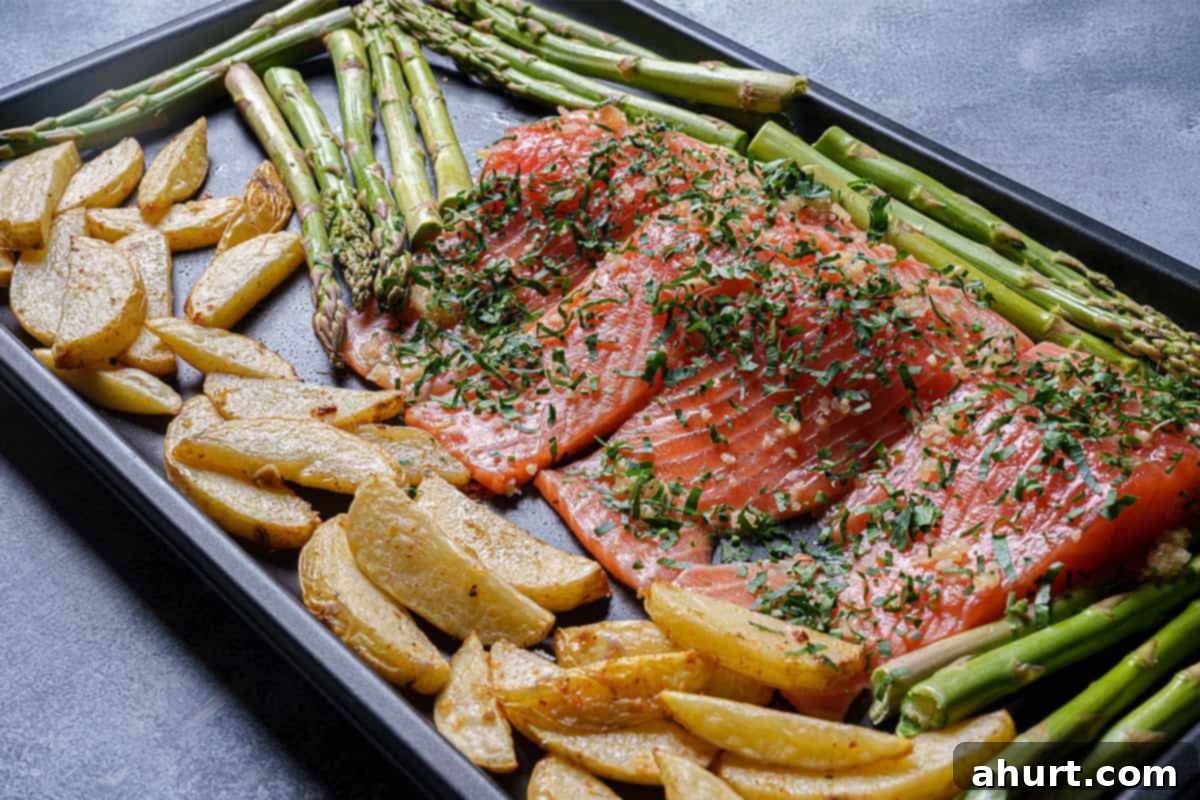
- Arrange Salmon and Asparagus: Once the potatoes have had their head start, gently push them to one side of the baking sheet. Create space in the center for your salmon fillets, arranging them in a single layer. Evenly rub the salmon with the specified amount of minced garlic and fresh chopped parsley – this infusion of flavor is key! Finally, add the asparagus spears to the other side of the pan, ensuring they also have room to roast properly without overcrowding.
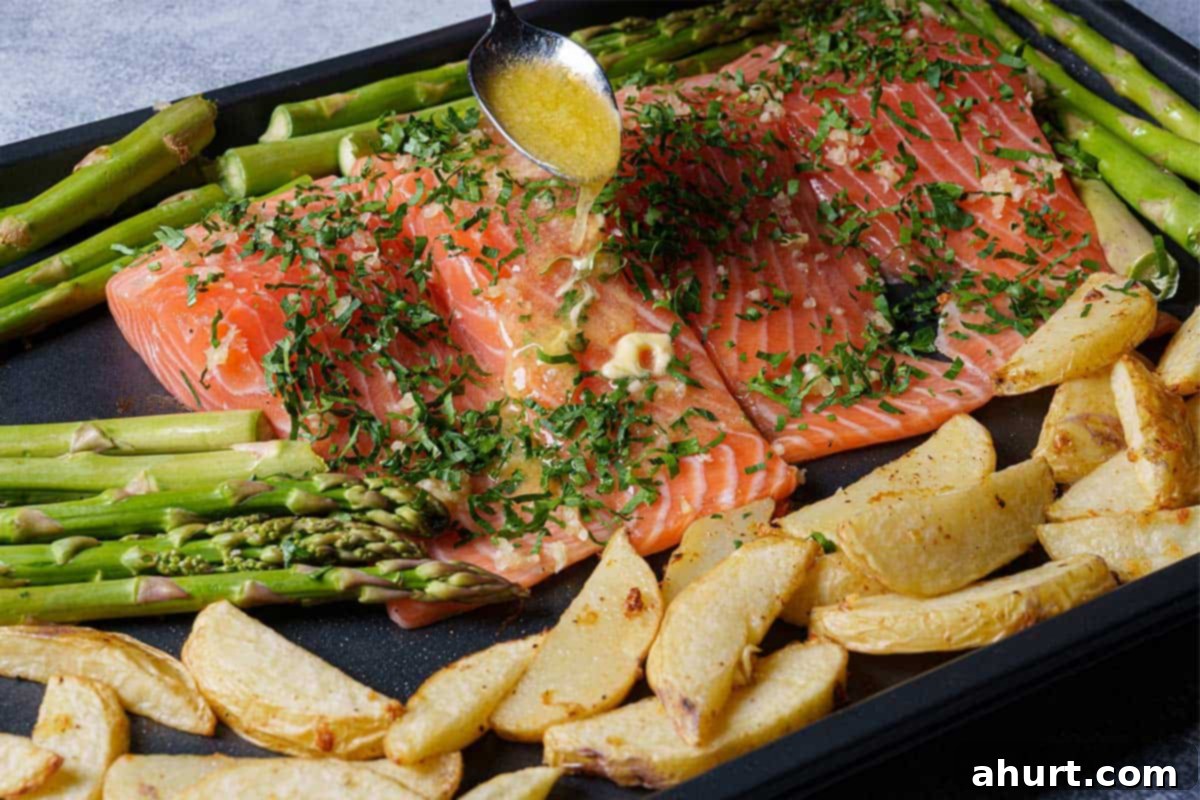
- Add the Lemon Butter Sauce: In a small bowl, whisk together a portion of the fresh lemon juice and the specified amount of melted butter. This creates your primary baking sauce. Drizzle this glorious mixture evenly over both the salmon fillets and the asparagus. Don’t forget to season everything generously with the remaining salt and freshly cracked black pepper. This step ensures every component is coated in deliciousness.
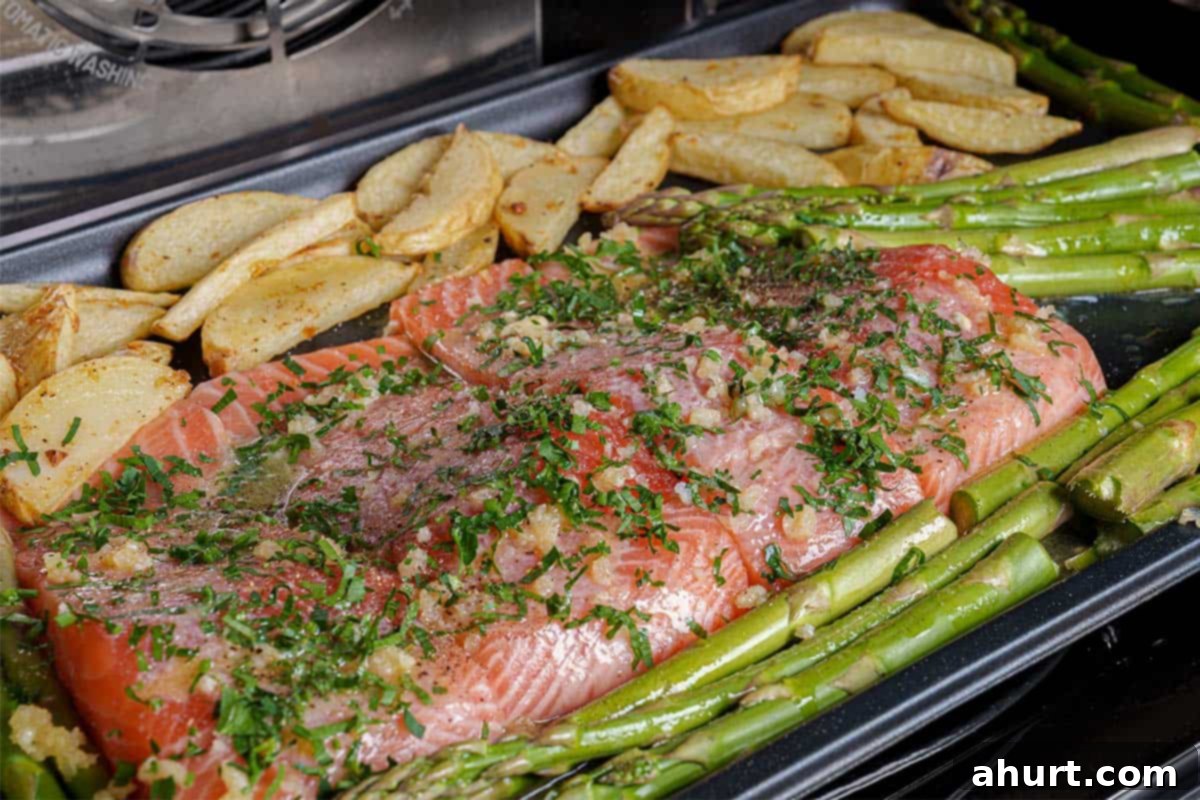
- Continue Baking to Perfection: Return the baking sheet to the preheated oven. Continue to bake for approximately 10 minutes. The salmon is perfectly cooked when it becomes opaque throughout and easily flakes with a fork. The potatoes should be golden-brown and fork-tender, and the asparagus should be bright green with a slight snap.
*Pro Tip for Crispy Edges: For an extra layer of texture and a beautifully charred finish on your salmon and veggies, switch your oven to broil for the last 2 minutes of cooking. Keep a very close eye on it to prevent burning!
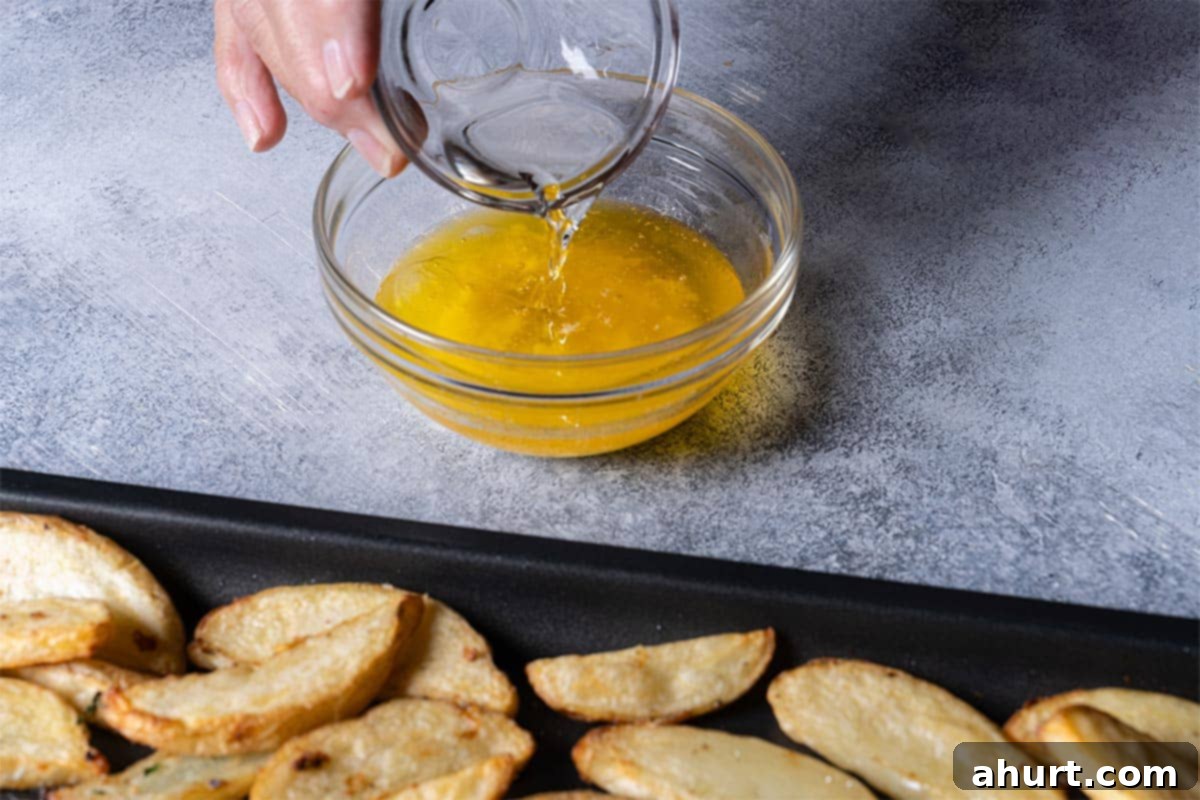
- Prepare the Finishing Sauce: While your salmon and vegetables are finishing up in the oven, prepare the final touch. In a small bowl, combine the remaining melted butter, minced garlic, and lemon juice. Whisk in the dry white wine (or chicken stock) until well combined. This vibrant sauce will be poured over the cooked dish, adding an extra layer of fresh, zesty, and garlicky goodness.
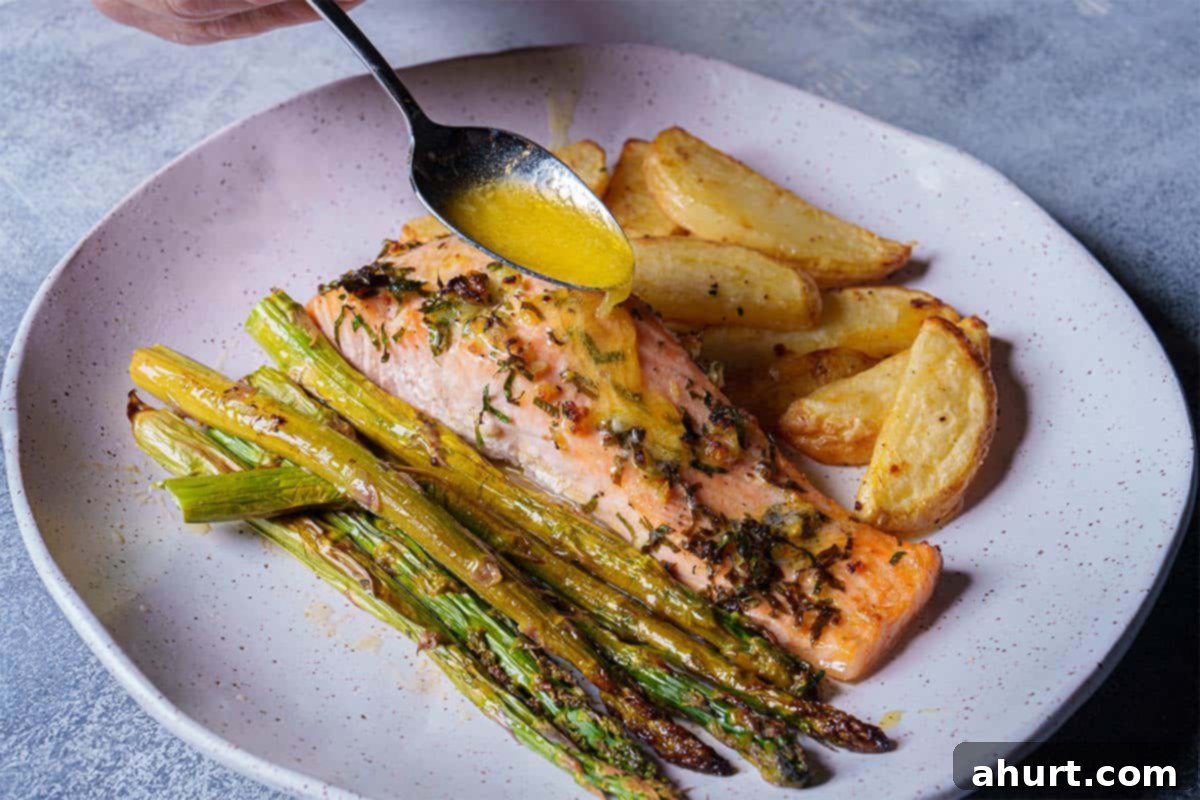
- Serve and Enjoy: Once everything is perfectly cooked, carefully remove the sheet pan from the oven. Drizzle the freshly prepared finishing sauce over the salmon, potatoes, and asparagus. Garnish with fresh lemon slices and an extra sprinkle of parsley for a burst of color and flavor. Serve immediately and savor every delicious bite of this magnificent **Garlic Butter Baked Salmon**!
Now that you’ve mastered the art of making this incredible **Garlic Butter Baked Salmon**, it’s time to consider the perfect accompaniments! For a savory and satisfying crunch, try our Parmesan Roasted Carrots. If you’re looking for another rich and flavorful vegetable option, our Garlic Butter Roasted Brussels Sprouts are an excellent choice. And for more easy, flavor-packed salmon-inspired magic, don’t miss our One Pan Lemon Garlic Baked Salmon and Asparagus. Happy cooking and enjoy every forkful!
Garlic Butter Baked Salmon: Recipe FAQs
A chilled glass of white wine is an exquisite pairing for **baked salmon**, especially with the richness of garlic butter. For this specific dish, a crisp, slightly aromatic white will beautifully complement the flavors. We particularly enjoyed a glass or two of chilled Moscato, as its subtle sweetness provides a delightful contrast. If sweeter wines aren’t quite your preference, you absolutely can’t go wrong with a good Pinot Gris or a vibrant Sauvignon Blanc. Both offer refreshing acidity and fruity notes that will enhance the salmon and its buttery sauce without overpowering it. Cheers to a perfect pairing!
To keep your cooked **Garlic Butter Baked Salmon** fresh, store it promptly in an airtight container. Alternatively, you can wrap it tightly in aluminum foil or plastic wrap. When properly stored in the refrigerator, it will maintain its quality for up to 3 days. While you technically can freeze cooked salmon for longer storage (up to 2 months), we generally do not recommend it for this recipe. Freezing and thawing can significantly alter the delicate texture and flavor of the salmon, making it less enjoyable than when freshly prepared.
Absolutely, using frozen salmon is perfectly fine for this **baked salmon recipe**! The most crucial step is to ensure it is completely thawed before you begin cooking. The best way to thaw frozen salmon is to transfer it from the freezer to the refrigerator 12-24 hours before you plan to cook it. This slow thawing process helps maintain the salmon’s texture and moisture. Avoid thawing at room temperature or in hot water, as this can affect its quality. Once thawed, pat the salmon fillets thoroughly dry with paper towels to ensure they bake properly and absorb the delicious garlic butter sauce.
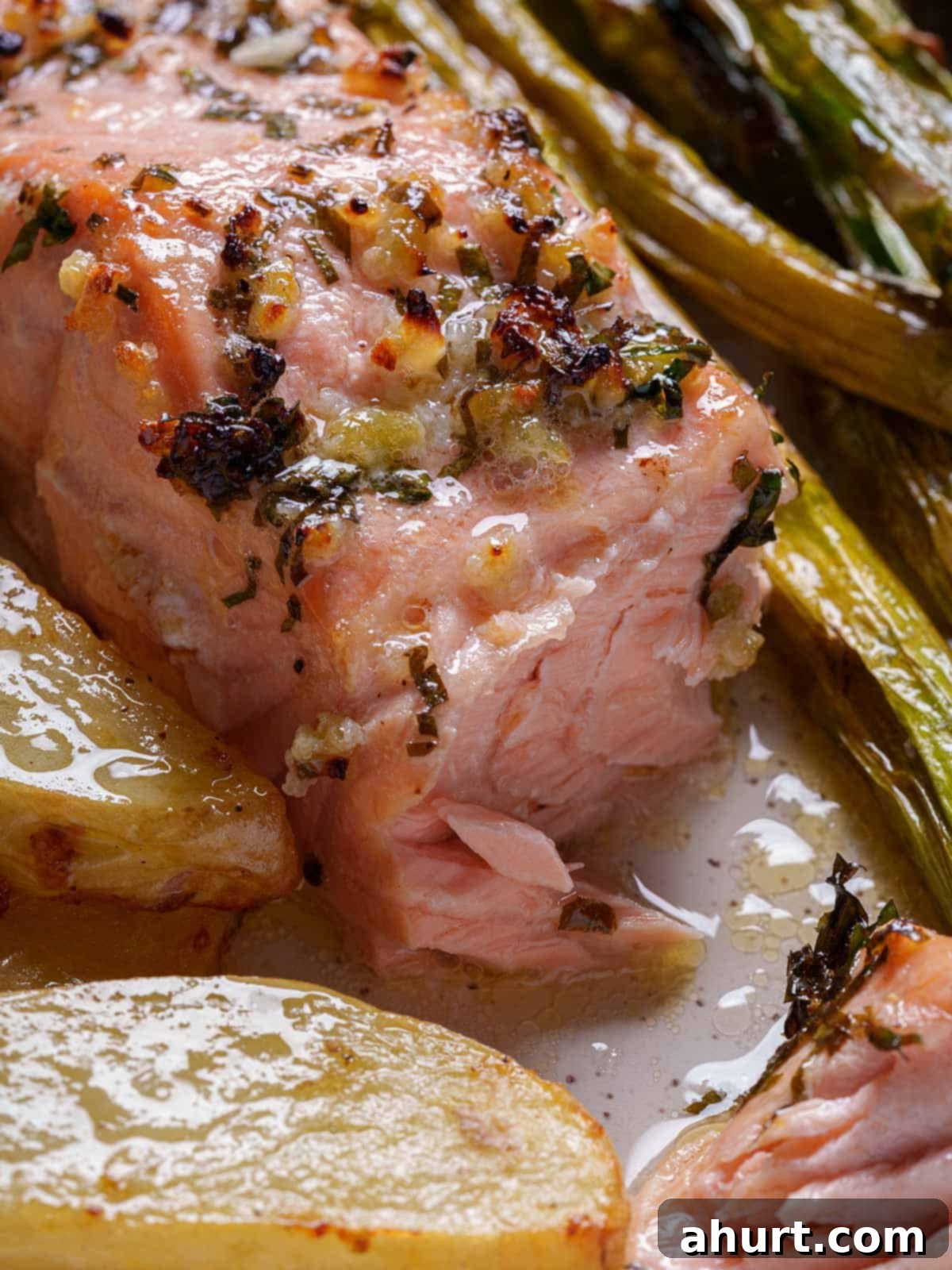
Ready to get the full recipe details? Here’s everything you need to make this incredible Garlic Butter Baked Salmon!
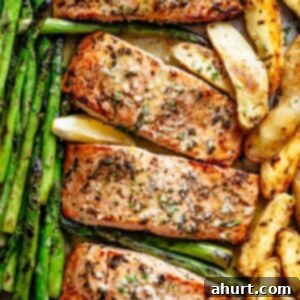
Saved
Pin
Garlic Butter Baked Salmon
Karina
10 minutes
25 minutes
35 minutes
4
people
Ingredients
-
1
pound
fingerling potatoes
or Yukon golds or halved white/red baby potatoes, halved – for that perfect crispy texture. -
2
tablespoons
olive oil -
1 1/2
teaspoons
salt
divided – for seasoning both the veggies and salmon. -
1/2
teaspoon
black pepper
cracked, divided – fresh cracked pepper adds so much flavor. -
4
skinless salmon fillets
– about 6 oz each, fresh for best results. -
2 1/2
tablespoons
minced garlic
divided – fresh is always best for robust flavor. -
2
tablespoons
fresh parsley
chopped – for vibrant color and fresh herbaceous notes. -
1/3
cup
lemon juice
freshly squeezed – essential for brightness and balancing the richness. -
1/2
cup
unsalted butter
melted – for that rich, luscious garlic butter sauce. -
3
asparagus
bunches, 18 spears, woody ends removed – for a perfect tender-crisp vegetable side. -
2
tablespoons
dry white wine
substitute with 1/4 cup low-sodium chicken broth if preferred, adds depth to the finishing sauce. -
1
lemon
sliced to garnish – for a beautiful presentation and extra citrusy zing.
Instructions
-
Preheat your oven to 400°F (200°C). On a large rimmed baking sheet, combine the potatoes with the olive oil, 1/2 tablespoon of the minced garlic, 1/2 teaspoon of salt, and 1/4 teaspoon of black pepper. Toss everything thoroughly to ensure the potatoes are evenly coated. Spread the potatoes out in a single, even layer on the baking sheet and roast for an initial 15 minutes, allowing them to soften and begin to brown beautifully.
-
Carefully push the partially cooked potatoes to one side of the sheet pan to make room. Arrange the four salmon fillets down the center of the pan, ensuring they are not touching each other or the potatoes too much for even cooking. Generously rub the salmon evenly with 1 1/2 tablespoons of the minced garlic and 2 tablespoons of the fresh chopped parsley. Finally, add the asparagus spears to the other empty side of the pan.
-
In a small bowl, whisk together 1/4 cup of fresh lemon juice and 1/4 cup of the melted unsalted butter to create a flavorful sauce. Pour this aromatic lemon butter mixture evenly over all the salmon fillets and the asparagus. Season the entire pan of ingredients with the remaining salt and black pepper, ensuring everything is well-seasoned for maximum taste.
-
Return the baking sheet to the preheated oven and continue baking for approximately 10 minutes, or until the potatoes are golden and tender when pierced with a fork, and the salmon is cooked through and opaque throughout (it should flake easily). For an irresistible char on the edges of your salmon and vegetables, you have the option to broil for the final 2 minutes. Watch closely to prevent burning!
-
While the salmon is finishing baking, prepare your luscious finishing sauce. In another small bowl, combine the remaining melted butter, garlic, and lemon juice. Whisk in the dry white wine (or chicken stock if you prefer a non-alcoholic option) until thoroughly blended. This sauce will be drizzled over the cooked dish for an extra boost of flavor and moisture. Serve the perfectly baked salmon, crispy veggies, and lemon slices immediately, with the prepared finishing sauce on the side or drizzled over. Enjoy!
Notes
Nutrition
Calories:
617
kcal
|
Carbohydrates:
24
g
|
Protein:
37
g
|
Fat:
41
g
|
Saturated Fat:
17
g
|
Polyunsaturated Fat:
6
g
|
Monounsaturated Fat:
15
g
|
Trans Fat:
1
g
|
Cholesterol:
155
mg
|
Sodium:
960
mg
|
Potassium:
1.409
mg
|
Fiber:
3
g
|
Sugar:
2
g
|
Vitamin A:
1.043
IU
|
Vitamin C:
37
mg
|
Calcium:
60
mg
|
Iron:
3
mg
Nutrition information is automatically calculated, so should only be used as an approximation.
Tried this? Leave a comment below!
